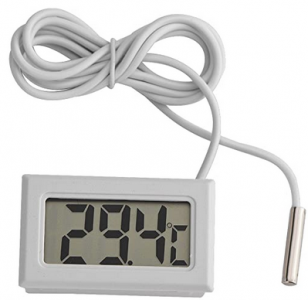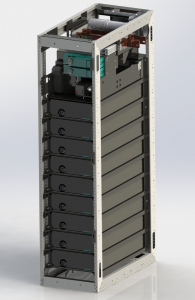Battery Charging Anomalies
sorry for any confusion - it was the only reference I could find to charging and temperature!
I don’t think you are alone @dunlorn there are two people in our village with solar/battery systems - not puredrive and they report the same problem. Both are convinced it is temperature related.
One has apparently surrounded the batteries with Kingspan insulation and says that it fixed the problem.
To be clear - above is NOT advice. It does show others have similar issue. I’d be chasing installer, solis and pure drive for answers. Someone wrote some code- they must know how the charging current is set and if what you are experiencing is ‘expected’ behaviour.
Our experiences with solar pv, ASHP, battery, and EV: ourhomeelectric.co.uk
@dunlorn the BMS (electronics) in each battery will have at least one temperature sensor. Maybe more.
Can you actually see what they read when using the App?
I'm still not convinced that the battery temperature is too low once the sun has been up a few hours.
But there is a possibility that a temperature sensor isn't in the right place...
... or that it's become disconnected from the BMS.
If so, it's a simple job of clipping it back in!
Save energy... recycle electrons!
Thanks all. This is useful insight and, yes, I am in discussion with the installer about this. He in turn is chasing Solis and Puredrive. I'll post any update once I get something meaningful.
I can't access any temperature info from the app unfortunately, although - to Derek's point - I do wonder if the battery internals are a few degrees below ambient, especially since the batteries are sited on a north facing elevation in shadow. I too am contemplating building a small insulated enclosure so pleased to hear it fixed things for someone else. I'll definitely ask the question about the temperature sensor though.
2 x 12kW Samsung Gen6 ASHP, 5.6kW solar PV ground mounted c/w 10kWh Puredrive battery & Solis inverter.
I think it would be helpful if you had an independent method of measuring temperature.
Look at this £6 unit from Amazon
Having the 'external' sensor on the end of a wire means that you can place it inside a battery case, but still read the temperature from the display outside.
The only precaution I'd take is to place a thin layer of PVC insulation tape around the metal sensor, just in case it should fall across two internal contacts!
Or, of course, you could use PVC tape to hold it in a particular position inside the battery box.
For anyone else watching this, who isn't in a hurry, you can get these temp-sensors very much cheaper if you buy direct from China.
There are variations on the length of lead and whether you also want to measure humidity.
Save energy... recycle electrons!
In my day job I'm designing systems that support fire-rated battery rooms with 200kVA Siemens Bluevault Li-Ion 230V UPS batteries. They require a room temperature between 15-25degC, the optimal is 20degC. That's common for most Li-Ion tech. Manufacturer's data may give a wider range for both storage and use, but the BMS may limit their charge and discharge current rating. This is well known for both Li-Ion and Ni-Cad batteries.
One of the problems with solar PV installers or DIY-ers locating batteries in, say, attics or garages, is that they can be subject to very wide ambient summer and winter temperature variations, and that will limit their functionality and performance at both ends.
@allyfish thanks for that.
”This is well known for both Li-Ion and Ni-Cad batteries.”
Wish it was. Nothing about charge rate vs temperature in any of the domestic battery brochures/specs I’ve scanned. And as you say batteries are being installed in attics and garages and even outside up and down the country.
Ho hum
Our experiences with solar pv, ASHP, battery, and EV: ourhomeelectric.co.uk
Most days I find that a comment on this forum provokes me to do a bit of research. Today it's the turn of @allyfish 🙂
It seems that Seimens BlueVault batteries are using Li-MNC chemistry, and are substantially marketed to the marine industry.
Does that mean they're Seamen's batteries? 😉
I don't know what model @allyfish is using, but the general format utilises liquid-cooled enclosures, each containing nine battery modules.
There's an excellent technical 'briefing' by Ketil Aagesen, Head of BlueVault Technology at Siemens Energy, which is worthwhile reading on LinkedIn.
The main reason he gives for a temperature controlled environment is to avoid shortening the 'life' of the battery. That is well documented, but LiMNC chemistry (Manganese, Nickel, Cobalt) is still used extensively for Electric Vehicles due to its capacity/mass ratio. That allows EVs to accelerate quickly and offer longer range between recharging.
The same is not the case for most domestic home-storage batteries.
Commercial and DIY installations in the home are using LiFePO4 chemistry.
Yes, the capacity is lower per Kg, but few of us are worried about the lack of acceleration in our houses.
Equally, many end-users would like to avoid a lithium chemistry which utilises Cobalt.
Not only can it have damaging effects on the environment, but its mining operations are marred by gangs and modern-slavery.
Guidance from manufacturers states that LiFePO4 technology shouldn't be charged below 0°C, but that doesn't prevent their widespread deployment in camper-vans, mainly in USA.
Installations below 0°C generally use BMS units which incorporate a heating control port, such as the JK B2A8S20PH from Jiakong.
Within a couple of years I expect to see much wider use of Lithium Titanate (LTO) cells for sub-zero static locations.
They have yet lower capacity, and their output is only 2.3v per cell. But they can be charged at -20°C without loss of performance or lifetime degradation.
LiFePO4 and LTO chemistry are much more stable than LiMNC.
They can be damaged by direct physical attack, but they produce far less heat and arcing.
As such, they are better suited for domestic installation.
Save energy... recycle electrons!
- 26 Forums
- 2,396 Topics
- 54.3 K Posts
- 281 Online
- 6,077 Members
Join Us!
Worth Watching
Latest Posts
-

RE: Power outages and storms: A surprisingly good DNO experience
@majordennisbloodnok honestly, it was genuinely refresh...
By Mars , 3 minutes ago
-

RE: Setback savings - fact or fiction?
As far as I am aware, the majority, if not all, of the ...
By cathodeRay , 9 minutes ago
-
RE: Advice for a novice on Mitsubishi Ecodan 6kW
Fair point. The highest frequency of defrosts I'd seen...
By Sheriff Fatman , 11 hours ago
-

RE: Heatpunk Floor plan issues
It's usually the complete opposite... seldom that Safar...
By Mars , 11 hours ago
-
RE: RDSAP10 effect on existing heat pump EPC rating?
@mike-patrick interesting update - thanks.I've been thr...
By Tim441 , 12 hours ago
-
RE: Recommended home battery inverters + regulatory matters - help requested
I remember reading in some inverters. They mandate a se...
By Batpred , 13 hours ago
-

RE: Fan is clipping ice build up from the front of unit.
@majordennisbloodnok I’ll not go there thanks! Toodles.
By Toodles , 14 hours ago
-

RE: Running from backup generaor in powercut?
@majordennisbloodnok Back in the 80’ or 90’ we had a te...
By Toodles , 14 hours ago
-
RE: Running my new Nibe ASHP efficiently
I'm new to the forum. Did you get a reply to this last ...
By Mike @ Camelot , 15 hours ago
-

RE: ASHP Energy Consumption: Aira 12kW heat pump
@grantmethestrength MCS requirements for DHW capacity h...
By Toodles , 16 hours ago
-
RE: New Mitsubishi Ecodan 11.2kW installation - L9 errors and maybe more
Great to hear! I just figured this out a day or tw...
By anotherdaveuk , 17 hours ago
-
RE: Help me keep the faith with my air source heat pump installation
@adamk I'm observing my own system at low temperatures ...
By dr_dongle , 22 hours ago
-

RE: Free Ecoheat Heat Pump Install
@deltona Yes older houses are problematic like that, bu...
By bontwoody , 2 days ago
-
RE: Radiator sizing sanity check
As I mentioned early on the cost of supplying and fitti...
By JamesPa , 2 days ago
-
RE: Electricity price predictions
Great point, one of the key ones in my chat with Octopu...
By Batpred , 2 days ago
-

RE: New Fogstar 15.5kWh upright solution
Let me point out that there are many Chinese suppliers ...
By Transparent , 3 days ago
-

RE: Weather compensation- why you should use it
@majordennisbloodnok — The Two Ronnies Mastermind sketc...
By cathodeRay , 3 days ago
-
Just realised that this image of the cylinder cupboard ...
By Sheriff Fatman , 3 days ago
-

RE: Rodents! A word of warning for heat pump owners
Two thoughts: 1: Let's ask @david-s if Primary Pro in...
By Transparent , 3 days ago







